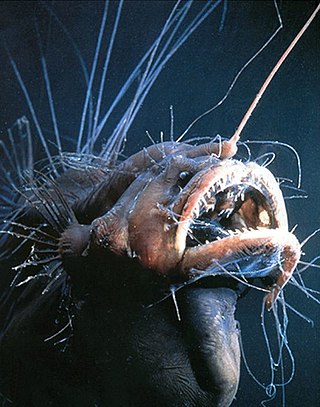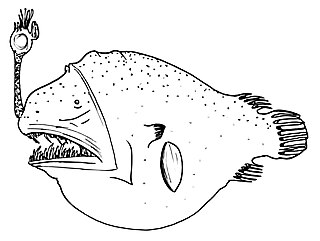
Leftvents are a family, the Linophrynidae, of marine ray-finned fishes which is classified within the suborder Ceratioidei, the deep sea anglerfishes. These fishes are found in the Atlantic, Indian and Pacific Oceans.

The footballfish form a family, Himantolophidae, of globose, deep-sea anglerfishes found in tropical and subtropical waters of the Atlantic, Indian, and Pacific Ocean. The family contains 23 species, all of which are classified in a single genus, Himantolophus.

Ceratiidae, the warty sea devils, caruncled seadevils or seadevils, are a family of marine ray-finned fishes belonging to the suborder Ceratioidei, the deep-sea anglerfishes, in the anglerfish order Lophiiformes. The warty sea devils are sexually dimorphic with the small males being obligate sexual parasites of the much larger females. The fishes in this family are widely distributed from polar to tropical seas around the world.

Fanfins or hairy anglerfish are a family, Caulophrynidae, of marine ray-finned fishes within the order Lophiiformes, the anglerfishes. The fishes in this family are found almost around the world in the deeper, aphotic waters of the oceans.

Oneirodidae, the dreamers are a family of marine ray-finned fishes belonging to the order Lophiiformes, the anglerfishes. These fishes are deepwater fishes found in the Atlantic, Indian and Pacific Oceans, and it is the most diverse family of fishes in the bathypelagic zone.

The triplewart seadevil is a species of marine ray-finned fish belonging to the family Ceratiidae, the warty sea devils, and the order Lophiiformes. This species is the only member of its genus. Noted for its extreme sexual dimorphism, the triplewart seadevil's length ranges from 20 to 30 cm for females and 1 to 3 cm for males.
Bertella is a monospecific genus of marine ray-finned fish belonging to the family Oneirodidae, the dreamers, a family of deep sea anglerfishes. The only species in the genus is Bertella idiomorpha and this can be distinguished from other members of the family by the structure of its hyomandibular bone.

The horned lantern fish or prickly seadevil is a species of marine ray-finned fish, it is the only species in the monotypic family Centrophrynidae. This species has a circumglobal distribution and is distinguished from other deep-sea anglerfishes by various characters including four pectoral radials, an anterior spine on the subopercular bone, and a short hyoid (chin) barbel in both sexes.

Caulophryne is a genus of marine ray-finned fishes belonging to the family Caulophrynidae, the fanfins or hairy anglerfishes. These fishes are found throughout the non-polar oceans of the world.

Linophryne, the bearded seadevils, is a genus of marine ray-finned fishes belonging to the family Linophrynidae, the leftvents. These deep sea anglerfishes are found in the Atlantic, Indian and Pacific Oceans.

Chaenophryne is a genus of marine ray-finned fish belonging to the family Oneirodidae, the dreamers, a family of deep-sea anglerfishes. These predatory, deep-sea fishes are found in the tropical and subtropical oceans around the world. Like other deep-sea anglerfishes, they are sexually dimorphic, with the matamorphosed females dwarfing the metamorphosed males. The males are not sexual parasites.
Dolopichthys is a genus of marine ray-finned fish belonging to the family Oneirodidae, the dreamers, a family of deep sea anglerfishes. These predatory, deep-sea fishes are found in the tropical and subtropical oceans around the world.

The plainchin dreamarm is a species of marine ray-finned fish belonging to the family Oneirodidae, the dreamers, a family of deep sea anglerfishes. It is the only species in the monospecific genus Leptacanthichthys. This species occurs in the North Atlantic and North Pacific Oceans at depths down to 2,000 m (6,600 ft).
Microlophichthys microlophus, the short-rod anglerfish, is a species of marine ray-finned fish belonging to the family Oneirodidae, the dreamers, a family of deep sea anglerfishes. This anglerfish is found in the deeper waters of the tropical and temperate oceans around the world.
Microlophichthys is a genus of marine ray-finned fish belonging to the family Oneirodidae, the dreamers, a family of deep sea anglerfishes. The species in this genus are found in the tropical and subtropical parts of the Atlantic, Indian and Pacific Oceans.

Oneirodes is a genus of is a genus of marine ray-finned fish belonging to the family Oneirodidae, the dreamers, a family of deep sea anglerfishes. These predatory, deep-sea fishes are found around the world. This is the type genus, and the most speciose genus, of the family Oneirodidae. They are sexually dimorphic but, like most taxa within their family, the small males are free living and are not sexual parasites on the larger females. Only the females are used to identify the species in this genus as no species specific charaxcters have been found for males.

Pentherichthys is a monospecific genus of marine ray-finned fish belonging to the family Oneirodidae, the dreamers, a family of deep-sea anglerfishes. The only species in the genus is Pentherichthys atratus which is found in the bathypelagic zones of the tropical and subtropical Atlantic, Indian and Pacific Oceans. The males of this species are dwarfed and are not parasitic on the females.

Chaenophryne longiceps, the can-opener smoothdream, longhead dreamer or smooth-head dreamer, is a species of marine ray-finned fish belonging to the family Oneirodidae, the dreamers, a family of deep sea anglerfishes. This predatory, deep-sea fish is found in tropical and subtropical oceans around the world. Like other deep-sea anglerfishes, it is sexually dimorphic with the metamorphosed females dwarfing the metamorphosed males, though the males are not sexual parasites.

Ceratioidei, the deep-sea anglerfishes or pelagic anglerfishes, is a suborder of marine ray-finned fishes, one of four suborders in the order Lophiiformes, the anglerfishes. These fishes are found in tropical and temperate seas throughout the world. One of the better known traits of the deep-sea anglerfishes is their extreme sexual dimorphism where the males are many times smaller than the females, the males seek out females and use their sharp teeth to clamp onto the females where he remains for the rest of his life, in some species he becomes part of the female. This is the only known natural example of a process called parabiosis. Another common trait of deep-sea anglerfishes is that they use bioluminescence on their esca to attract prey in the darkness of the deep oceans they inhabit.
Chaenophryne melanorhabdus is a species of marine ray-finned fish belonging to the family Oneirodidae, the dreamers, a family of deep-sea anglerfishes. This predatory, deep-sea fish is found in the Pacific Ocean. Like other deep-sea anglerfishes, dreamers are sexually dimorphic, with the matamorphosed females dwarfing the metamorphosed males. The males are not sexual parasites.
















